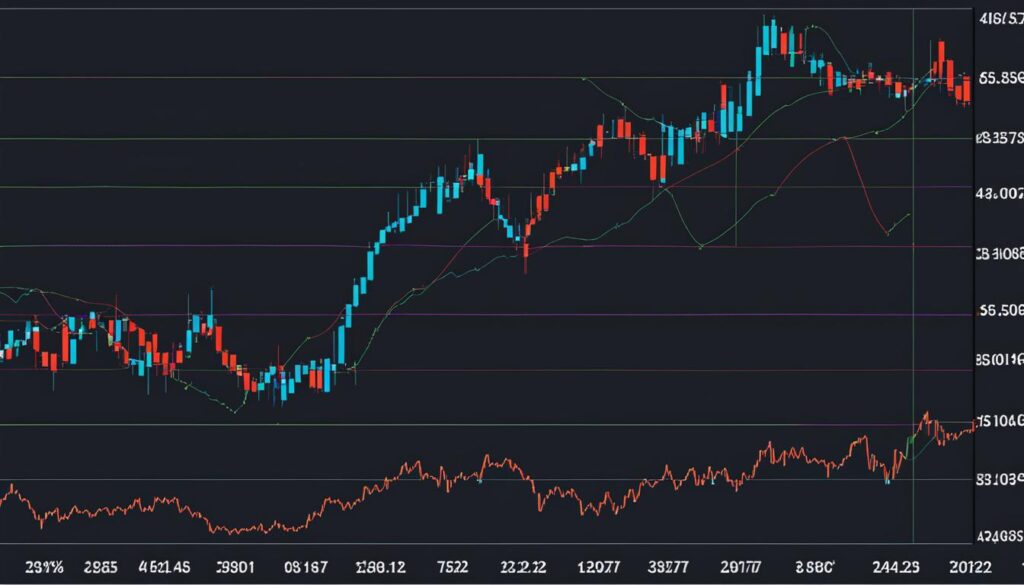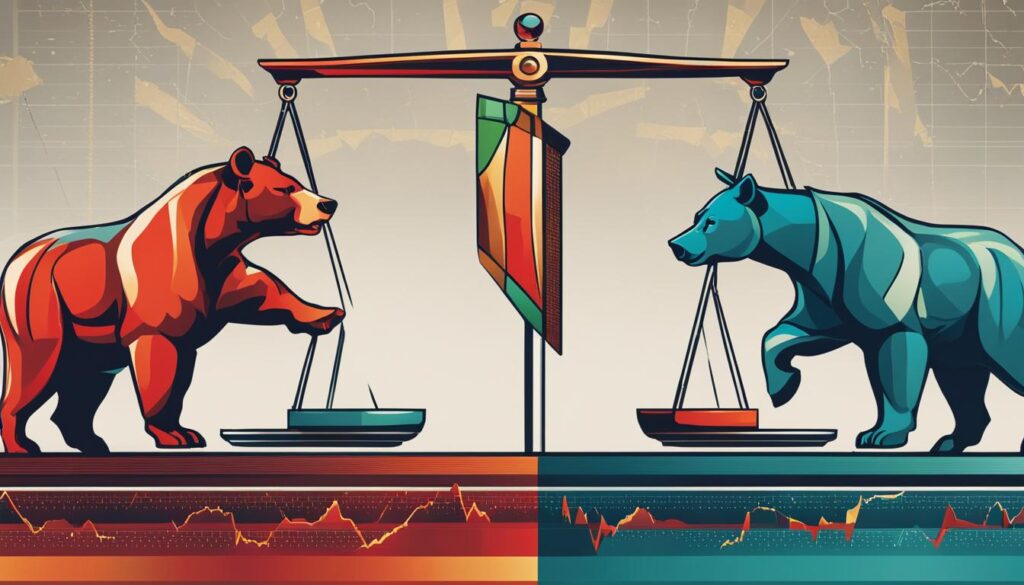When it comes to trading in volatile markets, advanced options trading strategies can provide opportunities for investors to profit from market fluctuations. One such strategy is trading VIX options, which are based on the Cboe Volatility Index (VIX). Understanding the ins and outs of VIX options is crucial for navigating these complex instruments effectively.
The VIX is a widely tracked market index that measures investor sentiment about future volatility. However, it is important to note that the VIX is not a direct indicator of stock market volatility but rather reflects how much people are willing to pay for S&P 500 index options. This distinction is essential for investors looking to trade VIX options.
Key Takeaways:
- Advanced options trading strategies can be lucrative in volatile markets.
- VIX options are based on the Cboe Volatility Index (VIX), which measures investor sentiment about future volatility.
- The VIX is not a direct indicator of stock market volatility but reflects the pricing of S&P 500 index options.
- Trading VIX options requires a deep understanding of their unique characteristics and complexities.
- Proper risk management is crucial when trading VIX options due to their potential for significant price movements.
Understanding the VIX
The VIX, or Cboe Volatility Index, is a key measure of investor sentiment and market expectations for short-term price changes (volatility) in the S&P 500 index. It is widely used to gauge market sentiment and the level of fear and uncertainty among investors. However, it is important to note that the VIX is not a direct measure of stock market volatility.
The VIX is derived from the prices of S&P 500 index options and represents the market’s expectations for volatility over the next 30 days. It reflects how much people are willing to pay for S&P 500 index options, which is influenced by investor sentiment. The higher the VIX, the higher the implied volatility and the greater the market’s expectation of price swings in the S&P 500 index.
When analyzing the VIX, it is crucial to differentiate between historical and implied volatility. Historical volatility measures past price movements, while implied volatility reflects the market’s expectations for future volatility. In options pricing, implied volatility is generally more relevant as it looks forward and plays a significant role in determining option prices.
“The VIX provides valuable insights into investor sentiment and can help traders anticipate potential market movements.” – John Smith, Options Trader
VIX options are useful tools for traders who want to bet on the future movement of volatility. By trading VIX options, investors can take positions based on their predictions about market sentiment and the level of fear or uncertainty among market participants. This allows them to potentially profit from changes in volatility, regardless of the direction of the stock market.
Implied Volatility and Options Pricing
Implied volatility plays a significant role in options pricing, including VIX options. As implied volatility rises, options prices tend to increase, reflecting the higher expected price swings in the underlying asset. Conversely, when implied volatility decreases, options prices tend to decline.
VIX options allow traders to not only speculate on the future movement of volatility but also hedge other positions in their portfolios. For example, if an investor has a portfolio of stocks and expects an increase in stock market volatility, they can buy VIX call options as a potential hedge. If the market experiences a sharp decline and the VIX rises, the gains from the VIX call options can help offset losses in the stock portfolio.
VIX Options and Investor Sentiment
The VIX is often referred to as the “fear gauge” because it can indicate the level of fear and uncertainty in the market. When the VIX is high, it suggests that investors are expecting significant price fluctuations and may be concerned about potential market downturns. On the other hand, when the VIX is low, it indicates that investors are relatively confident and expect relatively stable market conditions.
Traders can use the VIX as a contrarian indicator, taking positions in line with their interpretation of market sentiment. For example, if the VIX is at an extremely high level, indicating heightened fear and uncertainty, a trader might take a contrarian view and bet on a decrease in volatility.
In summary, the VIX is a valuable tool for understanding investor sentiment and market expectations for volatility. Traders can utilize VIX options to speculate on future volatility and potentially profit from changes in market sentiment. However, it is important to have a clear understanding of implied volatility and its impact on options pricing when trading VIX options.
Trading VIX Options
VIX options offer unique opportunities for traders to speculate on volatility expectations in the equity market. Unlike traditional equity options, VIX options have the expected value of the VIX at expiration as their underlying asset, rather than the real-time VIX itself. This distinction makes trading VIX options a specialized endeavor that requires a deep understanding of volatility dynamics and the factors that influence them.
One common trading strategy with VIX options is buying calls to bet on a rise in volatility. As volatility increases, the expected value of the VIX also tends to rise, potentially resulting in profitable outcomes for call buyers. Conversely, some traders purchase puts to play on expectations for a drop in volatility. By betting against rising volatility, put buyers can profit if their predictions come to fruition.
It’s important to note that VIX options have unique expiration dates. While equity and index options typically expire on the third Friday of each month, VIX options expire on the Wednesday that is 30 days prior to the third Friday of the next calendar month. This distinction should be taken into account when planning and executing VIX options trades.
Some investors also utilize VIX options as a hedging tool for their equity exposure. However, it’s essential to recognize that VIX options do not offer a precise hedge against equity market declines. This is because a steady decrease in the stock market doesn’t necessarily result in a major VIX spike. Understanding the limitations of VIX options as a hedging mechanism is crucial for effective risk management in portfolio strategies.

| Pros | Cons |
|---|---|
| Opportunity to profit from volatility expectations | Requires advanced knowledge and experience |
| Potential for portfolio hedging | Expiration dates differ from traditional equity options |
| Diversification through exposure to the VIX | Not a precise hedge against equity market declines |
Trading VIX options presents both benefits and challenges. The potential to profit from volatility expectations and the ability to hedge equity exposure make them an attractive vehicle for advanced traders. However, due to their unique characteristics and complexities, trading VIX options requires a high level of expertise and risk management.
Factors That Determine Option Prices
When trading VIX options, it is crucial to understand the factors that determine their prices. There are seven main factors to consider:
- Volatility: Volatility is the most vital factor in option pricing, especially for VIX options. It represents the expected price fluctuation of the underlying asset, and higher volatility generally results in higher option prices.
- Current Price of the Underlying Asset: The current market price of the underlying asset heavily influences option prices. As the stock price rises, call options become more expensive, while put options become cheaper.
- Strike Price: The strike price is the price at which the option holder can buy or sell the underlying asset. The relationship between the strike price and the current market price affects option prices. In general, options with strike prices closer to the current market price are more expensive.
- Type of Option: The type of option, whether it is a call or put option, also impacts pricing. Call options allow the holder to buy the underlying asset, while put options give the holder the right to sell. Call options tend to have higher prices when markets are optimistic, while put options are more expensive during periods of uncertainty.
- Time to Expiration: The time remaining until the option’s expiration date affects its price. Longer expiration periods generally result in higher option prices, as there is more time for the underlying asset to move in a favorable direction.
- Risk-Free Interest Rate: The risk-free interest rate plays a role in option pricing. Higher interest rates can increase the cost of carrying the underlying asset, resulting in higher call option prices and lower put option prices.
- Dividends: If the underlying asset pays dividends, it can affect option prices. Generally, higher dividend payments decrease call option prices and increase put option prices.
When evaluating the pricing of VIX options, it is crucial to consider the level of volatility in the overall market. The Cboe Volatility Index (VIX), which measures the market’s expectation for future volatility, can provide insights into the overall volatility environment and impact the pricing of individual stock options.
Understanding the factors that determine option prices is essential for effectively navigating VIX options trading. By considering these factors, traders can make informed decisions and develop strategies that align with their market expectations and risk tolerances.
Strategies to Trade Volatility
When it comes to trading volatility using VIX options, there are several advanced strategies that traders can employ. These strategies allow investors to take advantage of potential shifts in volatility and capitalize on market opportunities. Let’s explore some of the key strategies:
1. Long Puts
One popular strategy for traders who anticipate a rise in volatility and bearish market conditions is going long puts. By purchasing long puts, traders have the right to sell the underlying asset at a specific price (strike price) within a specified time period (expiration date). This strategy allows investors to profit if the stock price falls and volatility increases.
2. Short Calls
Shorting calls is another strategy used to trade volatility. This involves selling call options, giving the buyer the right to buy the underlying asset at a specific price within a specified timeframe. Traders can take advantage of high implied volatility by selling call options and earning premium income. However, it’s important to closely monitor the market as the underlying asset’s price can rise above the strike price, resulting in potential losses.
3. Short Straddles
Short straddles involve simultaneously selling both a call option and a put option with the same strike price and expiration date. This strategy is used when traders expect the underlying asset to have low volatility and remain range-bound. By selling both options, investors can earn premium income. However, if the underlying asset’s price moves significantly beyond the strike price, losses can occur.
4. Ratio Writing
Ratio writing is a strategy that involves selling more options than you buy, creating a net short position. This strategy can be used when traders expect moderate volatility and want to take advantage of time decay and decreasing implied volatility. It requires careful consideration and analysis of the risk-reward profile for each trade.
5. Iron Condors
Iron condors are multi-legged strategies that combine both long and short options to create a net credit position. They are typically used when traders expect the underlying asset to remain within a specific range and have low volatility. Iron condors involve selling an out-of-the-money call spread and an out-of-the-money put spread simultaneously. The goal is to earn premium income from both spreads while limiting potential losses within a specific range.
It’s important to note that each strategy has its own risk-reward profile and requires thorough analysis of market conditions and individual stock movements. Traders should consider their risk tolerance, investment goals, and market outlook before employing any strategy. Additionally, it’s crucial to stay updated on market trends and news that may impact volatility.
Remember, trading advanced options strategies like these involves significant risk and may not be suitable for all investors. It’s always recommended to consult with a financial advisor or professional before making any investment decisions.
Trading VIX-Related ETFs and ETNs
In addition to VIX options, investors can also trade VIX-related ETFs and ETNs. These include the iPath Series B S&P 500 VIX Short-Term Futures ETN (VXX), the iPath Series B S&P 500 VIX Mid-Term Futures ETN (VXZ), the ProShares VIX Mid-Term Futures ETF (VIXM), and the ProShares Short VIX Short-Term Futures ETF (SVXY). Each of these funds has its own characteristics and performance, and they allow investors to gain exposure to VIX futures or profit from changes in the expected volatility of the S&P 500 index.

Trading VIX Options: Benefits and Risks
When it comes to VIX options trading, there are several benefits and risks that investors should be aware of. Let’s take a closer look at what makes trading VIX options appealing and the potential challenges involved.
Benefits of VIX Options Trading
- Profiting from Changes in Volatility: VIX options provide traders with the opportunity to profit from fluctuations in market volatility. As the expected price swings increase or decrease, traders can capitalize on these changes and potentially earn significant returns.
- Hedging Equity Exposure: VIX options can also be used as a tool for hedging equity exposure. By incorporating VIX options into their portfolio, investors can mitigate the risks associated with volatile markets and potentially protect their equity investments.
Risks of VIX Options Trading
- Complex Nature of VIX Options: VIX options trading requires a deep understanding of volatility and its dynamics. The intricacies involved make it crucial for traders to possess a high level of knowledge and experience in trading volatility.
- Not Suitable for All Investors: Due to the complex nature and inherent risks associated with VIX options, they may not be suitable for all investors. It is essential to carefully evaluate one’s risk tolerance, financial situation, and investment goals before engaging in VIX options trading.
- Potential Losses: VIX options trading carries the risk of potential losses. Volatility can be unpredictable, and incorrect predictions or mismanagement of positions can lead to financial losses. It is crucial for traders to practice proper risk management techniques and have a clear understanding of the potential downsides.
To trade VIX options effectively, it is recommended for traders to consult with experienced professionals or conduct thorough research. Understanding the benefits and risks involved and implementing appropriate risk management strategies is key to navigating the complex world of VIX options trading.
Conclusion
Trading VIX options in volatile markets presents advanced strategies that offer investors opportunities to profit from changes in market volatility. To successfully trade VIX options, it is crucial to understand the VIX itself, its options, as well as associated ETFs and ETNs. By employing advanced trading strategies, such as going long puts and shorting calls, and utilizing complex option strategies like straddles and ratio writing, investors can navigate volatile markets and potentially achieve favorable returns.
However, it is important to recognize the risks involved in trading VIX options and to implement proper risk management techniques. Volatile markets can be unpredictable, and trading VIX options requires a high level of knowledge and experience. Investors should carefully manage their positions and be prepared for potential losses. It is advisable for traders to seek guidance from experienced professionals or conduct thorough research before engaging in VIX options trading.
In conclusion, advanced trading strategies involving VIX options provide a way for investors to capitalize on market volatility. By understanding the intricacies of VIX options and employing various strategies, traders can navigate volatile markets effectively. It is essential to weigh the potential benefits against the risks and exercise caution when trading VIX options in order to maximize the chances of success.
FAQ
What is the VIX?
The VIX, or Cboe Volatility Index, represents market expectations for the strength of short-term price changes (volatility) in the S&P 500 index.
Is the VIX a direct measure of stock market volatility?
No, the VIX is derived from the prices of S&P 500 index options and reflects the market’s expectations for volatility over the next 30 days.
What are VIX options?
VIX options are options contracts with the underlying asset being the expected value of the VIX at expiration, allowing traders to bet on future volatility.
How do VIX options differ from equity options?
VIX options expire on a different day than equity and index options, always on the Wednesday that is 30 days prior to the third Friday of the next calendar month.
What factors determine the price of a VIX option?
The price of a VIX option is determined by factors such as volatility (implied and historical), the current price of the underlying asset, strike price, time to expiration, risk-free interest rate, and dividends.
What are some strategies to trade volatility with VIX options?
Traders can employ strategies such as going long puts, shorting calls, short straddles, ratio writing, or iron condors to trade volatility using VIX options.
Can I trade VIX-related ETFs and ETNs?
Yes, investors can trade VIX-related ETFs and ETNs such as the iPath Series B S&P 500 VIX Short-Term Futures ETN (VXX), iPath Series B S&P 500 VIX Mid-Term Futures ETN (VXZ), ProShares VIX Mid-Term Futures ETF (VIXM), and ProShares Short VIX Short-Term Futures ETF (SVXY).
What are the benefits and risks of trading VIX options?
Trading VIX options can offer benefits such as the ability to profit from changes in volatility and the potential for hedging equity exposure. However, it is important to understand the risks involved and to use proper risk management techniques.



